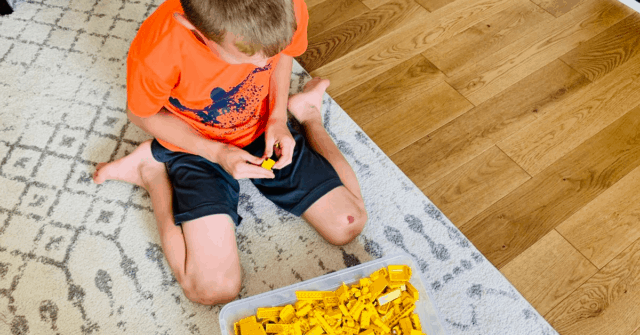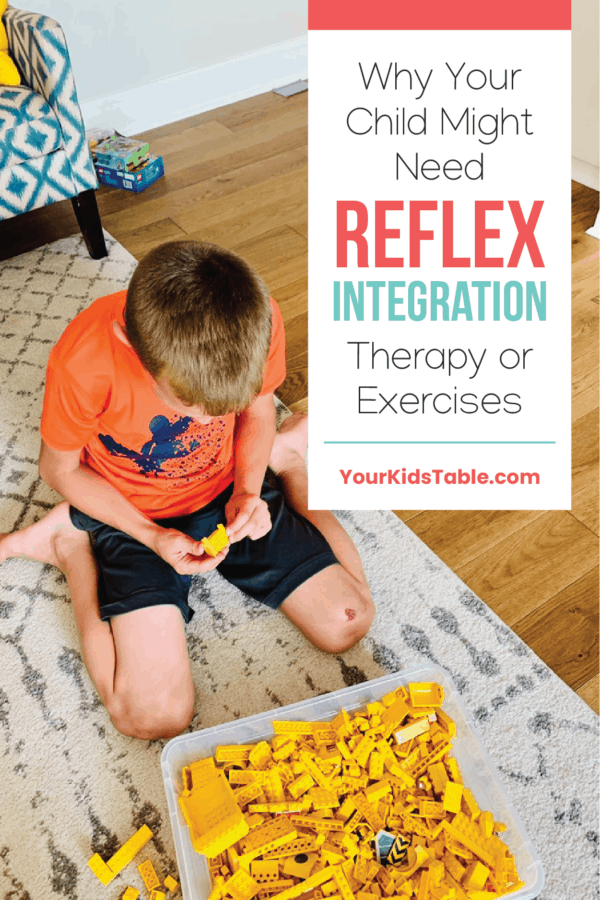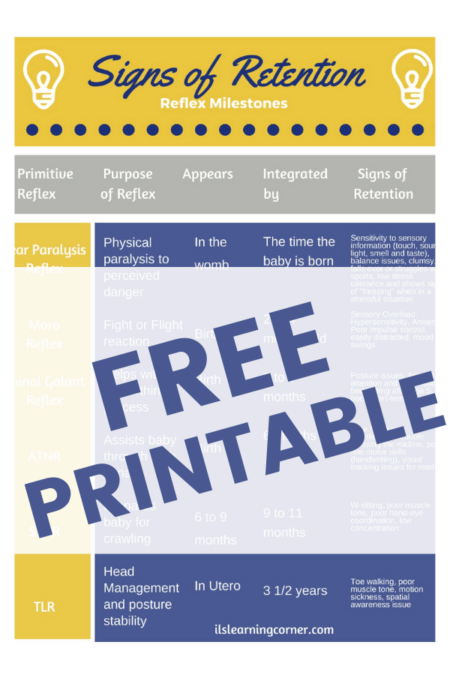Each child is born with a set of critical primitive reflexes to help them develop and keep them safe, but it’s important these reflexes disappear. Learn why and if reflex integration therapy is right for your child. *Affiliate links used below*.
So much happens beyond what we can see as our children grow and develop. It’s pretty extraordinary. But sometimes, seemingly hidden parts of our kids development can go awry. The result is all sorts of behaviors and challenges that parents don’t understand.
Maybe you can relate?
You wonder where you went wrong and despite reading the books, following the best blogs, and following advice to a T, your child still seems to struggle.
I want to introduce you to a powerful force of development that’s lying deep beneath the surface. You’ve probably never heard of it. It may sound a little strange. But it’s so important that you learn about it because without this hidden piece of development, you could keep spinning your wheels as you try to find a solution.
The critical part of development I’m talking about is Reflex Integration.
What is Reflex Integration?
From the moment your child was born, they had a set of reflexes to protect them from the world and help them navigate it. As an infant, if you stroked their cheek they would turn their head towards your hand. That’s a reflex to help them find the breast for nursing. At one time, it was integral to a babies survival.
There are many others, some of which I’ll share with you shortly, but obviously, your child doesn’t need that reflex at 5 years old. Actually, a baby doesn’t even need it at 6 months old.
While the reflex serves a very important role at a specific point in time, at the appropriate time, the reflex should fade away. Dissolve. Disappear. Or, in the therapy world we say – integrate.
Reflex integration is when specific developmental primitive reflexes are naturally phased out because they are no longer useful or necessary.
Reflexes are involuntary, meaning your child has no control of them. They aren’t making their head turn because you touched their cheek, they’re just reflexively moving.
If the reflex remains past the age it was supposed to disappear, those involuntary movements can affect children in all sorts of adverse ways.

Why Does Reflex Integration Matter?
The problem is that this integration or phasing out of reflexes doesn’t happen on it’s own for some kids. Instead, they retain these reflexes, and it’s usually not obvious that they have.
The reflexes continue to appear in subtle ways, but actually cause all sorts of challenges for a child.
There are so many different signs or red flags for reflexes that aren’t integrated. Here are just a few:
-
- Difficulty with gross motor movements such as running, jumping, catching, throwing, etc.
- Difficulty crossing midline or even bringing hands together
- Difficulty with eye tracking, which impacts learning in a traditional school environment
- Difficulty sitting still
- Wetting the bed past the age of 5
- Sitting often with legs spread out to side in a “w” formation.

Research has also suggested that children with retained reflexes can also have cognitive challenges, and it could be a factor or even cause of ADHD, Sensory Processing Disorder, or Autism.
However, a child may only have one or a few reflexes retained, and each retained reflex has it’s own set of “red flags”, although as you’ll see below, there is a lot of overlap as well.
It’s important to note, that if your child is struggling with any of these difficulties, it’s not necessarily primitive reflexes to blame. Wetting the bed for instance has a lot of causes. But, when you see a pattern and several challenges that persist despite using other strategies, it’s important to consider retained reflexes.
When Reflexes Should Be Integrated
There are a variety of primitive reflexes that each child is born with, and each of them should disappear or be integrated at different times. Here are a few examples:
Moro (Startle) Reflex – This reflex is triggered when a baby is startled. You’ll see them stretch their arms and legs out and then pull them back in tightly. They may also cry. This reflex usually disappears by 4 months and is present at birth. If it’s retained, it can cause:
-
- Poor impulse control
- Sensory overload
- Easily distracted
- Mood swings
- Hypersensitivity.

Symmetrical Tonic Neck Reflex (ATNR) – Doesn’t appear to around 6-9 months old and is present to prepare babies for crawling. You can witness this reflex by seeing your child’s legs straighten and their arms bend when their head moves forward. The opposite happens when they tilt their head back. It’s usually integrated by 9-11 months. If it’s retained, it can cause:
-
- Poor concentration
- Frequent w-sitting
- Difficulty with hand eye coordination
- Poor muscle tone.
Palmer Reflex – You probably remember this reflex well, the palmer reflex is when your baby grabs a tight hold of whatever is put into their palm, usually your pinky finger. It’s so endearing, but it’s totally involuntary. This reflex is present at birth and typically disappears around 5- 6 months old. If it’s retained, you may see:
-
- Writing difficulties
- Fine motor weakness
- Sticks out their tongue as they cut, draw, or concentrate on fine motor skills
- Hypersensitive to textures on their hand.
Spinal Galant Reflex – This reflex is triggered when you brush along one side of your babies spine with a firm pressure, the baby will shift to that side. It’s present at birth to help the baby get out of the birth canal, but is integrated around the age of 9 months. If it’s retained, you might see:
-
- Fidgety movements
- Bedwetting after age 5
- Poor attention and focus
- Poor posture
- Poor short term memory.
Rooting Reflex – Touch or brush up against your babies cheek and see them turn towards you. This reflex is present at birth, but should be integrated by 4 months old. If it’s not, you may see:
-
- Frequent drooling (*many causes to drooling for babies and toddlers)
- Difficulty chewing
- Thumb sucking
- Speech articulation difficulty.
Other primitive reflexes include:
-
- Plantar Reflex
- Sucking Reflex
- Stepping Reflex
- Tonic Labrinthine Reflex (TLR)
- Asymmetric Tonic Neck Reflex (ATNR)
Grab this printable from my favorite reflex integration experts at Integrated Learning Strategies to learn more about the signs and timelines for more reflexes! Click here to grab your copy
Does Your Child Need Reflex Integration Therapy or Exercises?
At this point, you’re probably wondering how to know if your child has retained any of these reflexes?
The first step I’d suggest is looking at the list of signs above and on the printable. Do you see several signs your child displays on one reflex? That’s an indication to dig a little deeper.
Talk to your child’s doctor about your concerns. While some occupational therapists and other professionals specifically test and provide specific exercises to help retain these reflexes, there’s also a lot you can start doing on your own. Plus, even if your child is being treated for retained reflexes, it’s critical that you’re following a home program.
Children benefit the most when they complete exercises 3-6 days a week.
The good news is that there’s a way to test for them, each reflex has a specific way to quickly assess if your child is still holding onto to these involuntary movements.
For example, to test for the rooting reflex, stroke around each side of your child’s mouth from their nose to their chin three times. Each time you stroke downwards, move out a little further. If you see any twitching in your child’s cheek, this is an indication that the rooting reflex has not integrated.
If you see that the reflex is still present in your 3, 7, or 12 year old, then it’s important to use specific reflex integration exercises so that the reflex can finally disappear. That means your child is no longer fighting against the involuntary movements of the reflex!
Integrating reflexes is a specialty and far more than I could ever cover in a blog post, but beginning to connect the dots to your child’s challenges and reflex integration is a HUGE step!
Get Inside Primitive Reflexes 101
If you’re ready to learn how to test for each of the reflexes and the specific exercises to complete with clear and simple video tutorials, then check out Primitive Reflexes 101 from the reflex experts at Integrated Learning Strategies.
This is a online class taught by a reflex integration therapy specialist with decades of experience working with children. It only opens 2x a year so don’t miss out. The doors will close soon.
Reflex Integration Therapy Research
Futagi Y, Toribe Y, Suzuki Y. The grasp reflex and moro reflex in infants: hierarchy of primitive reflex responses. Int J Pediatr. 2012;2012:191562.
Gietsztor, Ewa Z., Choinska, Anna M., Paprocka-Borowicz, Malgorzata (2016, 06-13). Persistence of primitive reflexes and associated motor problems in healthy preschool children. https://www.ncbi.nlm.nih.gov/pmc/articles/PMC5778413/
Edwards, Christopher W., Khalili, Yasir Al, (2020, 08-30). Moro Reflex. https://www.ncbi.nlm.nih.gov/books/NBK542173/
Masgutova, SK, Akhmatova, NK, Sadowska, L, Shackleford, P, Akhmatov, EA (2016, 02-01). Neurosensorimotor Reflex Integration for Autism: a New Therapy Modality Paradigm. http://masgutovamethod.com/_uploads/_media_uploads/_source/Jourrnal-Of-Pediatric-Neurological-Disorders-vol2-issue1.pdf
Alisha Grogan is a licensed occupational therapist and founder of Your Kid’s Table. She has over 15 years experience with expertise in sensory processing and feeding development in babies, toddlers, and children. Alisha also has 3 boys of her own at home. Learn more about her here.


My 9 year old son is still wetting the bed 5 of 7 nights a week. He was having dry nights (1-2 accidents per week) from 3-1/2 years old for several months until age 4, but it all reverted after a weekend at his grandparents when they had him wear a nighttime pant “just in case”. I’ve tried everything else.
Hi my 15yr old son still wets his bed sometimes.I thought he must have an immature bladder and as he grows it will stop but it hasnt yet.
What do you reccomend?
thank you,
Malka
Hi Malka! Thanks for reaching out! He’s still very young, and sometimes kids meet milestones at different ages. If it’s only happening occasionally, I wouldn’t worry too much about it. Especially since it can take longer for a child to stay dry during the night. If you’re looking for some potty training tips, we have a blog post about it here!
Best,
Kalyn
I think you overlooked – this lady wrote that her son is 15 yr (YEARS not months) old. Quite a bit past potty training age
My daughter hangs from furniture around the house. While hanging, her legs are contorted and she is using her crossed arms to hold her body up. She is 3, and she has been doing this since she was 1 & 1/2. It’s almost like a compulsion. She does it every day. Why??
Hi Amy! The hidden reason that she is completing these odd, quirky, and unusual actions is related to sensory processing. These actions may give calming sensations to the brain’s sensory processing. When the sensory system isn’t working as smoothly, kids often seek out more sensations OR try to avoid them. What you see as a result, are unusual body movements and actions, like those you mentioned. Try some proprioceptive activities to help!
Best,
Kalyn
My twins are 3.5 years old and are still not talking. No Autism etc, just speech and language delay. Would this therapy help them?
Hi Candice,
There are lots of reasons they might not be talking, and reflexes could be involved, but honestly I’d pursue services with a speech language pathologist to gain insight on this. Typically these reflexes are more closely tied to motor function, behavior, and attention/vision.
Best,
Laura
Your Kid’s Table team member
galant reflex…exercise snow angel